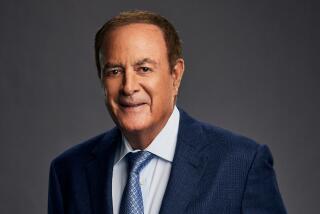For Twitch, it’s game on
- Share via
reporting from san francisco — Max Gonzalez settles into his home studio, where the former Home Depot cashier now makes a living playing video games full time.
He makes his final preparations before live-streaming his latest exploits over Twitch, the gamecasting service that has emerged as one of Silicon Valley’s hottest start-ups. He checks the lights, adjusts the three computer monitors on his desk, and looks over his shoulder at the green screen.
Gonzalez, 23, launches the live stream and starts playing “BattleBlock Theater.” He cracks jokes, provides running commentary, mocks his online opponents, makes funny noises. More than 1,800 fans are watching him online.
------------
FOR THE RECORD:
Twitch gamecasting: In the May 25 Business section, an article about gamecasting service Twitch attributed statistics on Internet traffic to a report from networking equipment company Sandvine Inc. Networking research firm DeepField released that report. The article also said Vanity Fair reported that YouTube was in talks to acquire Twitch. Variety published that story. —
------------
They respond with enthusiasm, typing comments into a live chat box that Gonzalez acknowledges with a friendly greeting or a snarky reply. Every couple of minutes, a “ping” sounds, announcing that another viewer has paid a $5 monthly subscription fee to support Gonzalez.
“It’s like a kind of talk show,” Gonzalez says. “Some people are watching just to hear me riff on the game. Some people are trying to pick up tips. It’s great, because Twitch has really exploded.”
Although Twitch has become a phenomenon in the gaming world, it flew under the radar of even many tech insiders until last weekend — when rumors surfaced that Google’s YouTube was in talks to buy it for $1 billion.
To non-gamers, it might seem weird that people would sit and watch someone else play a video game. Twitch’s stats say otherwise. It’s become the largest live-streaming site on the Web. During peak viewing times, it sometimes accounts for the fourth-highest traffic on the Internet, behind only Netflix, Google and Apple, according to statistics by Sandvine, a networking equipment company.
Although Twitch has soared by focusing narrowly on video games, observers say its success has larger implications. The ability to allow anyone to become a broadcaster has many analysts pointing to Twitch as a model for the future of television. Players like Gonzalez can push out a mix of live-streaming, social networking and interactivity with the press of a single button.
“What Twitch brings to it is the excitement of live possibility and the community,” said James McQuivey, a media analyst at Forrester Research. “It appeals to a very specific target, but that target consumes it rabidly.”
Twitch’s headquarters, home to 130 employees, is in San Francisco’s Financial District. The offices are decorated with vivid murals featuring giant animated figures inspired by games including “Pac Man” and “Minecraft.” A life-size model of the armor worn by the Brotherhood of Steel from “Fallout 3” stands in a hallway near robots and a replica of a gravity gun from “Half-Life 2.”
The calm and quiet of employees hunched over keyboards mask the frenetic pace of Twitch’s growth, racing at a pace that seems to have astonished even some of the company’s executives and investors.
In the three years since Twitch officially launched, its traffic has grown from 3.2 million unique viewers per month to 45 million. More than 1 million video game players broadcast themselves on the platform.
But the real jaw-dropper is the intense engagement of viewers. The average viewer watches 106 minutes of Twitch live streams per day. About 58% spend more than 20 hours a week watching videos on Twitch.
If that sounds crazy to non-gamers, it’s not, at least according to Twitch Chief Executive Emmett Shear.
“People have been watching people play video games since they were invented,” Shear said as he sat in a conference room named “Raccoon City” for the fictional setting of Capcom’s popular “Resident Evil” games. “If you think about old arcades, you spent much more time watching people play Pac Man than playing it yourself, because there weren’t enough games to go around.”
That habit vanished with the rise of affordable gaming consoles, Shear said. But Twitch is bringing that social element back.
On Twitch, people can watch both massive e-sports tournaments played by professional gamers and feeds by individual gamers who may not be greatly skilled but have strong personalities that make the viewing entertaining.
Viewers watch for the chance to chat live with players and pick up tips and strategies. But they also watch because, well, it’s just fun.
One Twitch fan is Jeffrey Rosen, 27, CEO of San Francisco e-commerce company Humble Bundle. Rosen, an avid player of Blizzard Entertainment’s “StarCraft” and “Hearthstone” games, estimates that he watches Twitch at least four hours each weekday and more on the weekends. During lunch breaks at the office, he sets up a projector to show Twitch on an office wall so colleagues can watch and dissect the action.
He acknowledges that his Twitch habit can draw puzzled looks when described to the uninitiated.
“Many people don’t understand the point of someone watching the game when you can play it yourself,” he said. “But it’s like sports. Why would you watch baseball when you could go play the game yourself? The difference is that now more people can relate to playing ‘StarCraft’ and ‘HearthStone’ than they can playing baseball.”
The folks at YouTube, where video gamers have been posting recorded and edited videos of themselves playing for years, are no doubt watching this closely, analysts say.
Last weekend, Vanity Fair reported that YouTube was in talks to acquire Twitch for $1 billion. Neither company would comment on the rumors. But analysts say Twitch has cracked the code for live streaming in a way no one else has, including YouTube.
Rosen, for instance, noted that his viewing has migrated to Twitch after years of watching recorded clips of gamers on YouTube that now seem stale to him by comparison.
“It used to be, go to YouTube and see how you beat a game,” said Michael Pachter, a research analyst at Wedbush Securities. “Now you have scheduled experts telling you how to beat a game on the day it comes out. The big difference between Twitch and YouTube is it’s by appointment live as opposed to archive. There’s something about the ephemeral nature of live.”
Although Twitch seems to have come out of nowhere, its roots go back to 2007, when the launch of a live-streaming company called Justin.tv enabled anyone to broadcast just about anything on the Web.
The company did OK, but it never caught a huge wave of growth to make it a major success. Along the way, though, Shear, one of the founders, noticed that video game players were going to elaborate lengths to connect their equipment to Justin.tv. So the company officially launched a gaming channel that quickly overwhelmed all other traffic on the site.
“It was a use case nobody had ever considered,” said Matthew DiPietro, Twitch’s vice president of marketing. “Gamers just came out of nowhere. This was surprising to everybody. But it just really answered a need and desire on the part of the gaming community to share their game play with each other. We really scratched an itch.”
Executives decided to re-launch the site to focus exclusively on video games. From that moment, Twitch has been on a rocket-ship ride.
The company now has 6,100 partners that include some of the most popular broadcasters, who can make money by offering $5 monthly subscriptions that give users access to special chat rooms, events or content. Those partners also include video game developers such as Electronics Arts, which began integrating Twitch into their games so players could broadcast with a single click.
Last year, the company got a major boost when Sony and Microsoft integrated Twitch into the new PlayStation and Xbox One consoles. “Minecraft” also recently added a feature to enable players to stream from within the game.
The ability to mix streaming and interactivity has inspired viewers to come up with their own uses for Twitch. One of the more notable phenomena on the site was something called “Twitch Plays Pokemon.” A programmer created a way to let users collaboratively play a Pokemon video game through Twitch.
During a 16-day stretch in March, more than 1 million players collectively played a single game of Pokemon, one keystroke at a time. McQuivey called Twitch Plays Pokemon a “a bizarre, once-in-a-decade kind of social phenomenon.”
For several years, the TV industry has been talking about the dynamic of second screens, in which people hold a smartphone or tablet to tweet or discuss a show with friends as they watch. But with Twitch, many of these features are all built directly into the platform, making it simultaneously both a viewing experience and a social network for gamers.
And that level of engagement and interaction, particularly among a very young audience that may never subscribe to cable, has advertisers intrigued.
“Twitch is very participatory,” said Jonathan Simpson-Bint, Twitch’s chief revenue officer. “It’s being used in ways by people that we never intended. If you can put your message in a place where people are creating something, that’s very attractive to advertisers.”
Despite the acquisition rumors, the company says it is not currently seeking additional funding and has more than enough cash on hand to fund its growth.
Ethan Kurzweil of Bessemer Venture Partners (and son of Ray Kurzweil, of “Singularity” fame) is a Twitch board member. Bessemer led a $15-million investment round for Twitch in September 2012 and participated in a second round of $20 million that included money from game developer Take-Two Interactive Software. Although Twitch now faces the challenge of expanding into mobile gaming, Kurzweil said that so far the company’s growth has exceeded his expectations.
“Everyone I told about this idea said it was so fringe that it would cap out at some point. Now it’s clear they’ve tapped into something latent on the Internet that could get a lot bigger.”
While big gaming names continue to rush in, the backbone of Twitch’s growth remains small, independent broadcasters like Gonzalez.
Just a couple of years ago, Gonzalez was working full time at Home Depot. In his spare time, he played games. Eventually, he started recording himself and posting on YouTube, where he now has more than 1 million subscribers.
He bought a high-quality mic and video camera, and a large green screen that he places behind him so viewers can see both him and the game while he plays.
As much as Gonzalez likes YouTube, Twitch is what thrills him. Editing videos for YouTube can be laborious. With live streaming, he just turns on the camera and he’s done. And he loves the ability to interact and chat with his fans. In fact, he met his current girlfriend, who also gamecasts on Twitch, in another player’s chat room.
Gonzalez doesn’t have a regular broadcasting schedule. He jumps on when the mood strikes him and alerts his 230,000 followers that he’s online. Between the cut of ad revenue he gets from YouTube and the subscription and advertising revenue he gets from Twitch, Gonzalez was able to quit his day job and just play video games.
“It’s great to see that people are really starting to pay attention to this kind of entertainment,” he said.
Twitter: @obrien
Times staff writer Andrea Chang contributed to this story.
More to Read
Inside the business of entertainment
The Wide Shot brings you news, analysis and insights on everything from streaming wars to production — and what it all means for the future.
You may occasionally receive promotional content from the Los Angeles Times.











